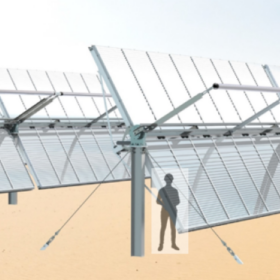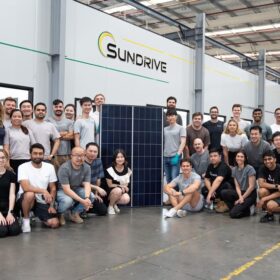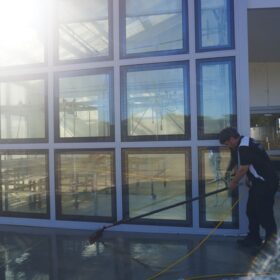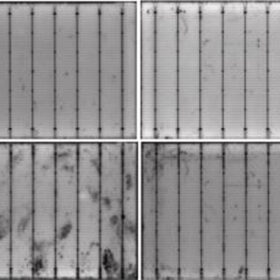Top News
Ergon plans ‘Queensland first’ microgrid in state’s far north

Concentrated solar plant turns to plastic mirrors to power clean heat

SunDrive strikes China pact to scale up copper PV technology
New May edition
pv magazine Webinar
pv magazine Webinar

ClearVue does manufacturing and distribution deal for NZ

Researchers warn of ‘hidden contaminants’ that could increase TOPCon, HJT solar module humidity-induced degradation
Fiji seeking consultants for 10 MW of solar
Aiko unveils back-contact solar module with ‘fully intelligent integration’
Victoria fast tracks approval for 700 MWh battery project
Press Releases
AusNet continues to invest in community energy resilience
Ennovi integrates advanced functionality with innovative busbar sealing technology in EV and hybrid drivetrains
Capral and PLP Australia deliver bespoke aluminium products for Project EnergyConnect
Gentari powers TM’s key operations with solar energy
Opinion & Analysis
Featured
Australia’s renewables future secured with Labor win
Harnessing the power of agrivoltaics: the future of sustainable land use
With the increasing pressure to decarbonise the energy system while preserving arable land and biodiversity, agrivoltaics is quickly becoming a vital pathway towards sustainable development. A new report from the IEA PVPS Task 13 lays out a compelling vision for how solar energy and agriculture can not only coexist but thrive together.
The rising energy demand from data centres: a global perspective
In recent years, the world has experienced a significant surge in the number of data centres, resulting in a rise in energy demand, posing both challenges and opportunities for the global energy sector.
How robotics is reshaping solar module installation
With module sizes increasing, labour shortages worsening and workplace safety risks escalating, automation is a necessity.
Data sharing vital to maximising benefits of EV batteries
Around the world, more and more electric vehicles are hitting the road. Last year, more than 17 million battery-electric and hybrid vehicles were sold. Early forecasts suggest this year’s figure might reach 20 million. Nearly 20% of all cars sold today are electric.
Albanese government announces $1.2 billion plan to purchase critical minerals
A re-elected Albanese government will take the unprecedented step of buying or obtaining options over key critical minerals to protect Australia’s national interest and boost its economic resilience.
Markets & Policy
Featured
US-based SEG Solar launches cell production in Indonesia
NSW targets 1 GW of energy storage with latest tender
New South Wales has launched a new tender seeking 1 GW of long-duration energy storage projects that are each able to continuously dispatch power for at least eight hours at their registered capacity.
Remote Vanuatu healthcare centres fitted out with rooftop solar
Australian government initiative REnew Pacific in partnership with disaster relief organisation Respond Global are installing 20 off-grid solar power systems and refurbishing 20 additional health facilities in Vanuatu, to enable reliable 24/7 electricity in some of the island nation’s most remote communities.
Quantum-based energy management method for PV-powered buildings
United States scientists have combined quantum computing with model predictive control to manage the energy of two solar-equipped university buildings in New York.
Remote community microgrid to remove 1.2 million litres of diesel
Further reducing their reliance on diesel fuel and pre-paid power cards, the remote Northern Territory community of Borroloola in the state’s Gulf Country is building a microgrid called the Ngardara Project, to enable affordable, reliable power for it’s residents.
AGL adds 1.4 GW of pumped hydro projects to pipeline
Australian energy giant AGL has added two pumped hydro projects with a combined capacity of almost 1.4 GW, each with 10 hours of energy storage, to its development pipeline as it works to transition its energy portfolio from coal-fired power generation to backed-up renewables.
Installations
Featured
Pacific expands east coast presence with NSW hybrid power system
7.15 GW of renewables and energy storage awarded rights to connect to NSW REZ
Ten large-scale solar, wind, and battery projects have been given the green light to connect to the electricity grid in the Central West Orana Renewable Energy Zone as the New South Wales government continues to progress the REZ to reality.
Sunshine State leads utility-scale solar chart
The latest data from Rystad Energy demonstrates why Queensland is known as the Sunshine State with the jurisdiction home to the country’s five best-performing utility-scale solar PV power plants in April.
Utility-scale solar tipped to reach 50 GW in five years
Australia’s solar sector is poised for significant growth in the next five years with a new report projecting utility-scale PV will exceed 50 GW total capacity by 2030, up from about 10 GW current operational capacity.
Surge in renewables delivers fresh records in NEM
New data released by the Australian Energy Market Operator details the growing reach of clean energy technologies with renewables, including grid-scale and rooftop solar providing 43% of the supply mix in the nation’s main grid during the first three months of the year.
Taiwan proposes mandatory solar for new buildings
The Taiwanese government has proposed new rules requiring PV installations on most new, expanded, or renovated buildings. The draft standards aim to boost renewable energy and decarbonisation by setting minimum solar capacity requirements, with potential exemptions for insufficient sunlight or technical issues.
Technology
Featured
Longi launches all-black back contact solar panel series
Powin introduces 6.26 MWh Pod Max containerised battery
Energy storage specialist Powin has launched Pod Max, a 6.26 MWh containerised lithium-ferro-phosphate battery system that delivers 25% more energy density than its standard 5 MWh product. The liquid-cooled unit targets grid-scale applications.
Canadian Solar debuts 660 W TOPCon solar panel with 24.4% efficiency
The new products are available in seven versions with power output ranging from 630 W to 660 W and power conversion efficiency spanning from 23.3% to 24.4%.
Silver-lean screen-printing can reduce silver use in TOPCon solar cells by 40%
Researchers from the University of New South Wales have teamed with international colleagues to develop a metallisation technique for TOPCon solar cells that can reportedly reduce silver usage in the devices’ rear side by 85%.
Longi launches residential HJT back-contact solar module with 25% efficiency
Longi has developed the Hi-MO S10, a residential heterojunction (HJT) back-contact solar module with 25% efficiency, combining 27.6%-efficient cells with up to 510 W output and 252.3 W/m² power density.
Australian wave energy developer strikes Alaskan deal
Western Australia-based Carnegie Clean Energy has inked an agreement that will see it explore the development of its wave power generation technology in waters off the coast of southcentral Alaska.
Manufacturing
Featured
Poweroad launches 233 kWh battery for C&I solar
Canadian Solar’s storage unit launches 5 MWh battery
The battery unit of the Chinese PV manufacturer said its new large-scale battery has a lifecycle of more than 12,000 cycles. The system has a nominal capacity of 5 MWh and a roundtrip efficiency of up to 95%.
Credence Solar unveils 600 W TOPCon PV panel
India manufacturer Credence Solar has unveiled the Hyper Nova N TOPCon module series available in power outputs from 580 W to 600 W with front-side power conversion efficiency of 22.45% to 23.25%, respectively.
Jolywood’s laser-assisted firing process increases TOPCon solar cell efficiency by 0.6%, says UNSW research
New research from the University of New South Wales have found that the Special Injected Metallisation (JSIM) technique developed by Chinese manufacturer Jolywood can considerably increase TOPCon solar cell efficiency. The scientists described precisely how laser-assisted firing enhances cell performance, reportedly filling critical gaps in industrial TOPCon cell optimisation.
Panasonic exits solar and battery storage
Panasonic has told its installation partners that it will no longer produce products for the residential solar and storage markets but will continue to offer warranty and installation support for existing and ongoing projects.
University researchers develop passive solar module cooling method
Researchers in Iran developed a passive solar module cooling method using silicon carbide porous ceramic. When combined with phase change materials, the technique reportedly boosts panel performance by up to 7.4%.
Energy Storage
Featured
AGL reaches battery milestone at retired coal site
National household batteries rebate scheme set to happen
The work schedules of Australia’s battery retailers and installers will likely get busy in the coming months with Labor’s win in the federal election paving the way for the introduction of a $2.3 billion national battery subsidy scheme.
Victorian urban solar farm to supply 98% of university’s energy demand
Victoria’s largest urban solar farm has been officially switched on at La Trobe University’s Melbourne campus, marking a major milestone in the university’s ambition to achieve carbon neutrality by 2029.
Macquarie’s offshoot Eku Energy secures Japanese long-term power source bid
Eku Energy, jointly owned by Australian financial services group Macquarie, has seen it’s Japanese subsidiary successfully bid for a long-term power source auction two months after a similar long-term energy services agreement was awarded in Australia for its Griffith BESS.
Queensland pilot plant turns seawater to hydrogen using solar energy
A Queensland university has released findings from its first stage hydrogen production pilot plant that uses solar energy, battery storage and a microgrid to produce hydrogen from non-drinkable water, such as seawater.
Three new Victorian community batteries to operate in virtual power plant
Energy from three new community batteries to be built by Melbourne-based Yarra Energy Foundation will be managed by Victorian electricity company Diamond Energy’s virtual power plant.


